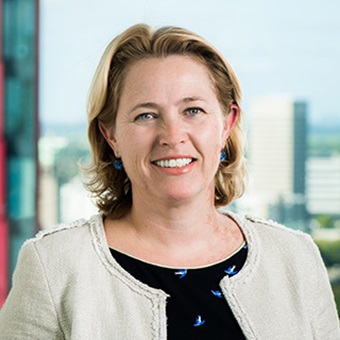Elske van de Burgt, CFA holds a Master degree in econometrics and operations research from the University of Maastricht. After joining Ortec Finance in 1997, she held different roles within the company. She has worked together with many international clients in the performance measurement, attribution and risk area. In 2006, she became Product Manager of Ortec Finance’s performance attribution solution. Elske’s current position is managing director of the Investment Performance group within Ortec Finance. She is responsible for all product related activities, including new implementations, support and sales as well as the Investment Performance Service that offers a fully outsourced solution for institutional investors around the globe. She also is a member of the company’s Management Team. Elske regularly writes articles and speaks at conferences about investment performance related topics.
David Spaulding: Please provide us with some background about yourself; feel free to touch on any aspect of your life that you’d like.
Elske van de Burgt: As you probably know, I was born and raised in the Netherlands, in a city near Rotterdam. At the age of 18 I moved out to study at the University of Maastricht, where I received my Master degree in Econometrics and Operations Research. In the early days of my professional career I also became a Chartered Financial Analyst® (CFA). In 1997, I joined Ortec for an internship, and actually never left the company. I started my career at Ortec Finance as a software developer, working on logistical applications. The thesis that I wrote, based on my internship, was about the optimal routing for container transportation in the harbor of Antwerp. This was followed by projects in the pension investment space. Very soon I was stationed at the Shell pension scheme, which is part of the Shell Asset Management Corporation, now known as SAMCo. At that time, Ortec was developing a performance attribution system in close cooperation with this client. This is how I got in touch with our profession and witnessed the birth of our PEARL application. I soon found out that I preferred the discussions with the clients and translating their needs into models and functionality over programming the actual software.
This resulted in involvement in numerous implementation projects, product management, and ultimately becoming the managing director of the team. In this role, I am responsible for the sales, implementation and support of our performance solutions. Our team of experts is based in the Netherlands, with colleagues in the U.K., Canada, Switzerland, and Hong Kong. With this team we serve our customers around the world.
In 2007, there was a management buy-out after which Ortec Finance was founded. I became part of the management team, and a shareholder of the company.
When my colleagues nominated me for the Women in Performance and Risk Measurement Award earlier this year they handed in a rather accurate description, so let me quote from that:
“If you were to ask her colleagues and clients about the kind of person Elske is, responses would include: very knowledgeable, strong-minded (and stubborn), straight, thoughtful, social etc. The red line through all responses boils down to almost two separate personalities. On the one hand a serious, determined, very knowledgeable and straight woman who truly understands client challenges and performance measurement to the deepest details. On the other hand, a very open and social women, mother of two children, who loves shopping, running and really appreciates the social time with clients and colleagues.”
DS: We know that yours is a global firm. My sense is that many of your clients are asset owners, though you also have asset managers as clients, and perhaps organizations from other segments of the market. Please contrast the needs of asset owners and asset managers.
EV: Our client base is a mix between asset owners and asset managers. On the asset owner side we serve pension funds, insurers and sovereign wealth funds. The asset managers on our client list are typically those that have a large institutional client base and want to differentiate themselves by tailored or specialized investment strategies that truly add value for their end clients. In order to support those strategies they need specialized tools for performance measurement and attribution. So having complex investment strategies in place is a common denominator among our clients. But to differentiate the two groups; asset owners primarily use our performance reports to get a better understanding of the quality of their investment decisions, and how to improve these. They also tend to allocate a considerable amount of assets in non-listed investments. Asset managers tend to be more focused on client reporting, efficient workflows, and a stable production process.
But having said this, we also work with asset owners that manage the majority of their multi-billion assets in-house, and have performance teams that are twice the size of a typical asset manager. So it’s not as black and white as you might expect it to be.
DS: When it comes to performance attribution, we know you had a hand in developing your approach. Please describe it for us.
EV: Our approach is based on the fundamental belief that performance attribution helps to improve future investment decision making. For this purpose, the attribution should be relevant; it needs to mimic your investment process. This is easier said than done, especially in organizations where decisions are made on different levels and by various groups of people. In those cases, there is often a mixture of top-down and bottom-up decisions.
While working with the Shell pension fund, we soon realized that there were some bottom-up models available, but that there was a need for a top-down approach. That is how our decision-based attribution model started. I really would like to take all the credit for this, but it was actually my colleague Jeroen Geenen who did most of the groundwork. In retrospect, we probably should have named the model after him.
The key of our unique approach is that we model each individual investment decision and measure the added value. This includes complex strategies and overlay structures. For the measurement, we primarily use existing attribution formulas or modified versions of these formulas. The top-down model can be combined with bottom-up models such that there will be one consistent set of (attribution) reports that cover every single investment and underlying decisions.
Organizations can use this information to identify their strengths and weaknesses. They can also monitor the amount of (ex-post) risk involved in each decision and compare this with their ex-ante expectations or risk budgets. This is of course very powerful input for their forward looking investment decisions.
DS: What changes have you found in terms of needs from your clients over the past ten years or so?
EV: Sometimes I feel that innovation within our field is limited and we only progress with very small steps. I guess that disruptive innovation doesn’t match well with our profession where it is all about stability, reliability and accuracy. But still, if you look back on the last 10 years, certainly our profession and clients have evolved. But it’s definitely more of an evolution than a revolution.
Ten years ago the discussion was all about performance calculations on security level and on a daily basis, as common practice before that was still monthly calculations on an aggregated level (i.e., sector or country). Next to that was the understanding that equity models were not necessarily suitable for fixed income investments, and with that the rise of specialized fixed income attribution methodologies.
In the last five years, we have seen an increasing demand for models that can support more complex investment strategies, including factor-based investing, dynamic re-allocations, liability-driven investments, strategy tagging, and the use of derivatives as part of such a strategy. Also, the impact of (foreign) currency on investments and the management as well as measurement of this impact has been in high demand over the past years, which is something that our models are well fitted for.
More recently we’ve observed increased interest among our clients in attribution solutions for private assets and more advanced uses of IRR and PME measures, even on a hedged or local basis. Also we see a growing demand for the incorporation of ESG factors in attribution models, which is a topic that our new Strategic Climate Solutions team is working on currently.
Besides changing needs in calculation methodologies, we also see increased demands with respect to efficiency and flexibility in the working processes of performance teams. This includes topics such as data management, modeling portfolios and benchmark structures, setting up analyses and flexible reporting. As a result, users of our PEARL software are expecting higher standards with respect to intuitive user interfaces, and clear application workflows. This is a topic we have recently invested heavily in, resulting in our three step approach for attribution.
DS: I know that you serve clients in multiple geographic markets, including New Zealand, Europe, the United States, and Canada. Do you find there to be much of a difference between their needs or structures, or are they pretty much the same?
EV: A large portion of the asset owners are non-profit or semi-government organizations and therefore tend to come together regularly to discuss latest trends and best practices. Because of this, we definitely see similar investment structures and needs around the globe. But of course each organization has its own unique structure. The long-term objectives they have can be considerably different, and that is reflected in their investment strategies. For us the challenge is to offer a solution that is both generic and highly standardized, but at the same time is capable of handling all of these particularities in an efficient way.
Regional differences certainly do exist though; in the U.K. we see a tendency for a more service oriented – opposed to software license model - approach. Also, liability driven investing, in some cases involving fiduciary management, is a trend in the U.K. In Canada as well as in the Asia/Pacific region, the portion of private assets is relatively large and still growing. In Northern Europe, ESG investing is picking up rapidly, while in the U.S. there is an increased interest in currency hedging and corresponding overlay programs. Although these differences are challenging, it’s also a great opportunity for me and my team to learn and spread our knowledge among our client base.
DS: What aspects of performance do you find your clients having the most challenges with?
EV: Well, of course our clients have a great tool to address any challenge they face with performance. I think that the greatest challenge for our clients is understanding the investment process within their organization and delivering reports that are tailored to the needs of their stakeholders. This holds for both asset owners and asset managers. If they manage to do so, the performance reports become very relevant and an integrated part of the investment decision making process.
But the road to get there is not always easy, and there is a balancing act between catering to every individual request and an efficient workflow. Before we implement our system we, therefore, always do a consulting study with our clients, in which we address this and define a solution (which is of course the software application, but also all connections and processes around it) to fulfill this goal in the best possible way. Throughout my career, I’ve always enjoyed participating in those studies a lot. I still try to do this occasionally as it is a great way to connect with our clients and hear firsthand how they intend to use our solutions. This is, of course, great feedback for our product development.
DS: We hear a great deal about the cloud as a place for software. Is this something you’re involved with, or have plans to be?
EV:We already offer clients the option to make use of the Ortec Finance Cloud to take away the burden of IT deployment and maintenance. Over the last five years, we’ve seen an enormous increase in the usage of this service, and we expect this to continue in the years to come.
DS: What else would you like to share with our readers?
EV: With respect to the development of our PEARL system, these are actually quite exciting times as we are currently on the edge of releasing PEARL 8.
As the PEARL solution has been in existence for more than 20 years, we decided a few years ago to start a large modernization project. We chose to adopt a phased evolution approach, in which different parts of the software are updated and improved over time. The end result of this project is PEARL 8, which we will release in a few months. We believe that this will strengthen our position as a specialized provider, and perfectly brings together our expertise with the latest technical innovations.
PEARL is used by a growing number of leading asset owners and asset managers worldwide. Get more from your performance reporting, and let PEARL help you to enhance your performance and master the complexity of investment decision making. Click here to find out more about PEARL.
To view the original journal interview in The Journal of Performance Measurement click here.
“The Journal of Performance Measurement is one of the essential publications for professionals in the investment management field. The quality and breadth of its articles published attest to its importance in furthering the body of knowledge and in improving the analytical standards used by investment managers and their clients.” To find out more about The Journal of Performance Measurement click here.
The Journal of Performance Measurement is a publication by The Spaulding Group. To find out more about The Spaulding Group click here.
Contact











